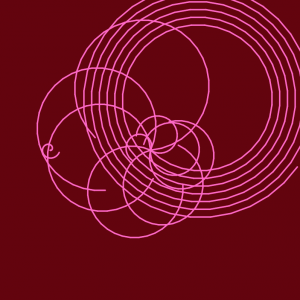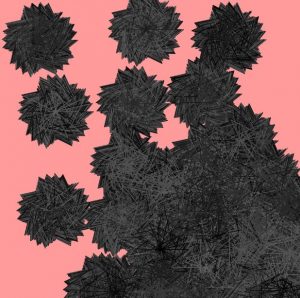sketch
var myTurtle;
var startFrame;
function setup() {
createCanvas(400, 400);
background(100);
myTurtle = makeTurtle(width, height);
myTurtle.setColor(color(255, 100, 200));
myTurtle.setWeight(2);
myTurtle.penDown();
resetCanvas();
frameRate(50);
}
function draw() {
var step = (frameCount - startFrame)/20.0;
myTurtle.forward(step);
myTurtle.left(10.0);
if (myTurtle.y > height) resetCanvas();
}
function resetCanvas() {
background(100,0,10);
startFrame = frameCount;
myTurtle.penUp();
myTurtle.goto(width/6, height/2);
myTurtle.penDown();
}
function mousePressed(){
myTurtle.penUp();
myTurtle.goto(width/2, height/2);
myTurtle.penDown();
}
function turtleLeft(d){this.angle-=d;}function turtleRight(d){this.angle+=d;}
function turtleForward(p){var rad=radians(this.angle);var newx=this.x+cos(rad)*p;
var newy=this.y+sin(rad)*p;this.goto(newx,newy);}function turtleBack(p){
this.forward(-p);}function turtlePenDown(){this.penIsDown=true;}
function turtlePenUp(){this.penIsDown = false;}function turtleGoTo(x,y){
if(this.penIsDown){stroke(this.color);strokeWeight(this.weight);
line(this.x,this.y,x,y);}this.x = x;this.y = y;}function turtleDistTo(x,y){
return sqrt(sq(this.x-x)+sq(this.y-y));}function turtleAngleTo(x,y){
var absAngle=degrees(atan2(y-this.y,x-this.x));
var angle=((absAngle-this.angle)+360)%360.0;return angle;}
function turtleTurnToward(x,y,d){var angle = this.angleTo(x,y);if(angle< 180){
this.angle+=d;}else{this.angle-=d;}}function turtleSetColor(c){this.color=c;}
function turtleSetWeight(w){this.weight=w;}function turtleFace(angle){
this.angle = angle;}function makeTurtle(tx,ty){var turtle={x:tx,y:ty,
angle:0.0,penIsDown:true,color:color(128),weight:1,left:turtleLeft,
right:turtleRight,forward:turtleForward, back:turtleBack,penDown:turtlePenDown,
penUp:turtlePenUp,goto:turtleGoTo, angleto:turtleAngleTo,
turnToward:turtleTurnToward,distanceTo:turtleDistTo, angleTo:turtleAngleTo,
setColor:turtleSetColor, setWeight:turtleSetWeight,face:turtleFace};
return turtle;}
This piece I was playing with the tension of pattern and the randomness when interfere with the continuous flow of pattern.

var myTurtle;
var startFrame;
function setup() {
createCanvas(400, 400);
background(100);
myTurtle = makeTurtle(width, height);
myTurtle.setColor(color(255, 100, 200));
myTurtle.setWeight(2);
myTurtle.penDown();
resetCanvas();
frameRate(50);
}
function draw() {
var step = (frameCount - startFrame)/20.0;
myTurtle.forward(step);
myTurtle.left(10.0);
if (myTurtle.y > height) resetCanvas();
}
function resetCanvas() {
background(100,0,10);
startFrame = frameCount;
myTurtle.penUp();
myTurtle.goto(width/6, height/2);
myTurtle.penDown();
}
function mousePressed(){
myTurtle.penUp();
myTurtle.goto(width/2, height/2);
myTurtle.penDown();
}
function turtleLeft(d){this.angle-=d;}function turtleRight(d){this.angle+=d;}
function turtleForward(p){var rad=radians(this.angle);var newx=this.x+cos(rad)*p;
var newy=this.y+sin(rad)*p;this.goto(newx,newy);}function turtleBack(p){
this.forward(-p);}function turtlePenDown(){this.penIsDown=true;}
function turtlePenUp(){this.penIsDown = false;}function turtleGoTo(x,y){
if(this.penIsDown){stroke(this.color);strokeWeight(this.weight);
line(this.x,this.y,x,y);}this.x = x;this.y = y;}function turtleDistTo(x,y){
return sqrt(sq(this.x-x)+sq(this.y-y));}function turtleAngleTo(x,y){
var absAngle=degrees(atan2(y-this.y,x-this.x));
var angle=((absAngle-this.angle)+360)%360.0;return angle;}
function turtleTurnToward(x,y,d){var angle = this.angleTo(x,y);if(angle< 180){
this.angle+=d;}else{this.angle-=d;}}function turtleSetColor(c){this.color=c;}
function turtleSetWeight(w){this.weight=w;}function turtleFace(angle){
this.angle = angle;}function makeTurtle(tx,ty){var turtle={x:tx,y:ty,
angle:0.0,penIsDown:true,color:color(128),weight:1,left:turtleLeft,
right:turtleRight,forward:turtleForward, back:turtleBack,penDown:turtlePenDown,
penUp:turtlePenUp,goto:turtleGoTo, angleto:turtleAngleTo,
turnToward:turtleTurnToward,distanceTo:turtleDistTo, angleTo:turtleAngleTo,
setColor:turtleSetColor, setWeight:turtleSetWeight,face:turtleFace};
return turtle;}
SaveSave
 I am interested in allowing people to question the reality. What make one thinks the object is real or not. There are many existing things in our daily spaces that are invisible to our five senses: sight, hearing, touch, smell, taste. Sometimes one can so blinded by one’s thoughts and the reality that the society create. How can one be encouraged to see beyond the curated reality, focusing on seeing and feeling the true forms.
I am interested in allowing people to question the reality. What make one thinks the object is real or not. There are many existing things in our daily spaces that are invisible to our five senses: sight, hearing, touch, smell, taste. Sometimes one can so blinded by one’s thoughts and the reality that the society create. How can one be encouraged to see beyond the curated reality, focusing on seeing and feeling the true forms.![[OLD FALL 2017] 15-104 • Introduction to Computing for Creative Practice](../../../../wp-content/uploads/2020/08/stop-banner.png)



 emergence of complexity in sound from fundamental sine and cosine waves, using tools like Houdini, Reason, Nuke, After Effects, and Processing.
emergence of complexity in sound from fundamental sine and cosine waves, using tools like Houdini, Reason, Nuke, After Effects, and Processing.






